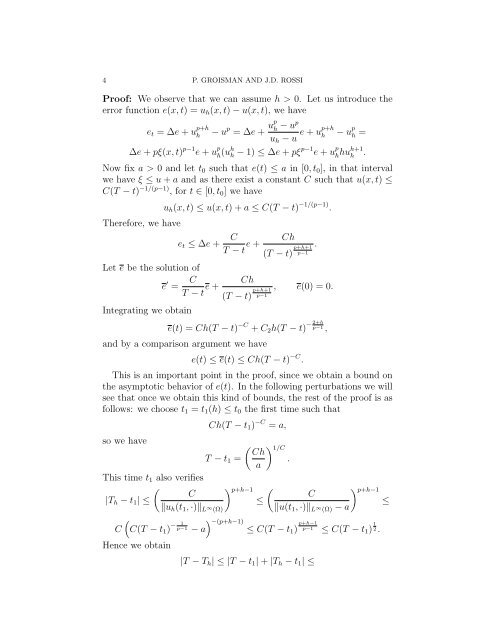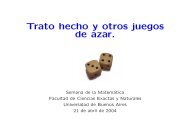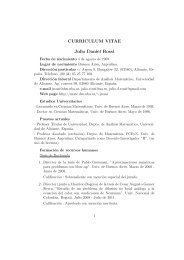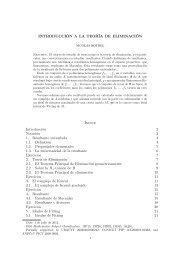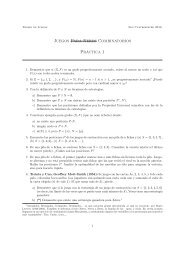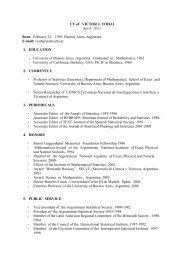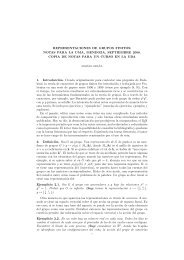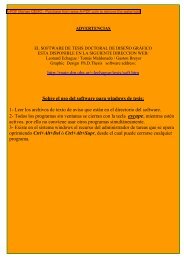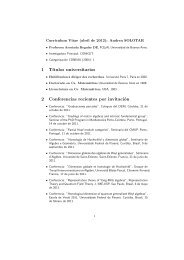Dependence of the blow-up time with respect - Universidad de ...
Dependence of the blow-up time with respect - Universidad de ...
Dependence of the blow-up time with respect - Universidad de ...
Create successful ePaper yourself
Turn your PDF publications into a flip-book with our unique Google optimized e-Paper software.
4 P. GROISMAN AND J.D. ROSSI<br />
Pro<strong>of</strong>: We observe that we can assume h > 0. Let us introduce <strong>the</strong><br />
error function e(x, t) = uh(x, t) − u(x, t), we have<br />
et = ∆e + u p+h<br />
h<br />
− <strong>up</strong><br />
− <strong>up</strong> = ∆e + <strong>up</strong><br />
h<br />
uh − u<br />
e + <strong>up</strong>+h<br />
h<br />
− <strong>up</strong><br />
h =<br />
∆e + pξ(x, t) p−1 e + u p<br />
h (uh h − 1) ≤ ∆e + pξ p−1 e + u p<br />
h huh+1<br />
h .<br />
Now fix a > 0 and let t0 such that e(t) ≤ a in [0, t0], in that interval<br />
we have ξ ≤ u + a and as <strong>the</strong>re exist a constant C such that u(x, t) ≤<br />
C(T − t) −1/(p−1) , for t ∈ [0, t0] we have<br />
Therefore, we have<br />
uh(x, t) ≤ u(x, t) + a ≤ C(T − t) −1/(p−1) .<br />
et ≤ ∆e + C<br />
e +<br />
T − t<br />
Let e be <strong>the</strong> solution <strong>of</strong><br />
e ′ = C<br />
e +<br />
T − t<br />
Integrating we obtain<br />
Ch<br />
(T − t) p+h+1<br />
p−1<br />
Ch<br />
(T − t) p+h+1<br />
p−1<br />
, e(0) = 0.<br />
e(t) = Ch(T − t) −C 2+h<br />
−<br />
+ C2h(T − t) p−1 ,<br />
and by a comparison argument we have<br />
e(t) ≤ e(t) ≤ Ch(T − t) −C .<br />
This is an important point in <strong>the</strong> pro<strong>of</strong>, since we obtain a bound on<br />
<strong>the</strong> asymptotic behavior <strong>of</strong> e(t). In <strong>the</strong> following perturbations we will<br />
see that once we obtain this kind <strong>of</strong> bounds, <strong>the</strong> rest <strong>of</strong> <strong>the</strong> pro<strong>of</strong> is as<br />
follows: we choose t1 = t1(h) ≤ t0 <strong>the</strong> first <strong>time</strong> such that<br />
Ch(T − t1) −C = a,<br />
so we have<br />
1/C Ch<br />
T − t1 = .<br />
a<br />
This <strong>time</strong> t1 also verifies<br />
<br />
C<br />
|Th − t1| ≤<br />
uh(t1, ·)L∞ p+h−1 <br />
C<br />
≤<br />
(Ω)<br />
u(t1, ·)L∞ (Ω) − a<br />
<br />
1 −(p+h−1)<br />
−<br />
C C(T − t1) p−1 − a<br />
Hence we obtain<br />
.<br />
p+h−1<br />
≤ C(T − t1) p+h−1<br />
p−1 ≤ C(T − t1) 1<br />
2 .<br />
|T − Th| ≤ |T − t1| + |Th − t1| ≤<br />
≤


